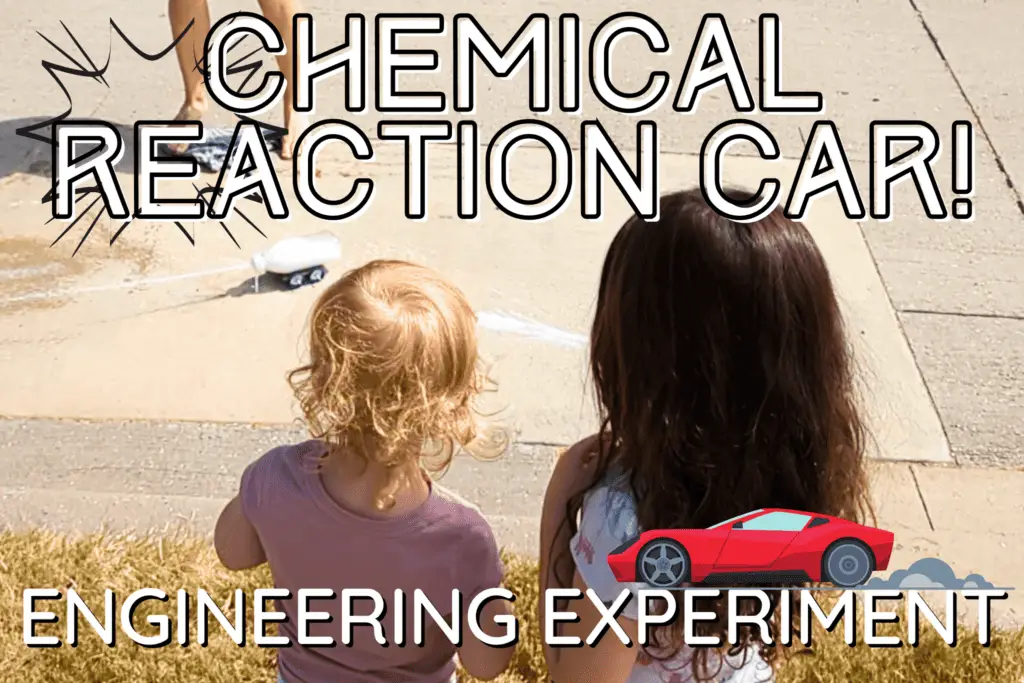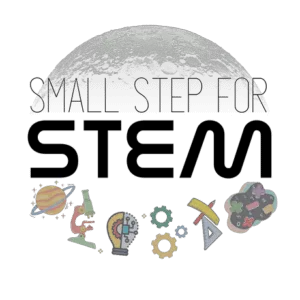Disclosure: this post contains affiliate links, which means I may receive a commission if you click a link and purchase something at no extra cost to you. Please check out our policies page for more details.
for more details.
The Rev Up engineering experiment is so great because it combines engineering with science while keeping your child engaged in the excitement!
This experiment involves science and engineering by building a chemical reaction vehicle while exploring scientific principles through basic chemical reactions.
Ready to race some cars? Let’s do it!

How to make the Rev Up with Engineering Fun engineering experiment
Supplies you will need
For this experiment, you will need the following:
- An empty plastic bottle
- Scissors
- 1/2 cup of white vinegar
- 1/2 cup of baking soda
- Hot glue gun

- A toy car (or make your own and just remove the balloon here)
- Single-ply toilet paper
- Optional: food coloring

Before you start
Watch your child when you initiate the chemical reaction!
Instructions
Here is how to do this experiment:
Step 1: Puncture a hole in the bottle cap

Using your scissors, carefully puncture a small hole in the bottle cap of the plastic bottle. This hole will be the exhaust for our car, where the baking soda and vinegar mixture spill out.
Step 2: Glue car to the side of the plastic bottle
If you do not have a toy car handy (or one large enough for the plastic bottle), no problem!
We built an easy homemade car with just a few household items that you can check out here. I’ll be using it for our experiment so you can take a look.
Once you have your car, use your hot glue gun to secure the plastic bottle to the top of the car. Be sure to place the end with the bottle cap on the back of the car so it drives forward.


Step 3: Wrap some baking soda in the toilet paper

Take your single-ply toilet paper (or just remove a layer from the toilet paper you have to make it single-ply) and lie it flat on the table. You’ll only need about 2-3 squares of it.
Sprinkle the baking soda in the middle of the toilet paper in a line. We are making it into a line so it’s easier to insert it into the plastic bottle.
Once you’ve sprinkled all of the baking soda, roll the toilet paper up and tightly roll the ends so the baking soda stays contained.
Insert the wrapped toilet paper into the plastic bottle.
Get your child involved: Have your child add the baking soda to the toilet paper and wrap it up!
Step 4: Add vinegar

Carefully pour your vinegar into the plastic bottle. If you have a funnel handy, it could help you pour it in without a mess.
If you want to add food coloring for a festive reaction, now would be the time to do it.
Once all of the vinegar is in the plastic bottle, quickly put the cap back on your plastic bottle.
The reaction will begin shortly, once the vinegar disintegrates the toilet paper and makes contact with the baking soda.
Get your child involved: Have your child add the vinegar if you have a careful pourer or are using a funnel.
Step 5: Let your car go!
Once the reaction begins and you see the liquid coming out of the plastic bottle, place your car on the ground and let it roll!
See how far you can get it to go with one chemical reaction. Once it’s done, rinse out your bottle and try playing with the ratios of vinegar and baking soda.
Do you get a bigger reaction with more vinegar? More baking soda? Does it matter?
These are great questions to ask your child and have them experiment with!
The engineering behind the Rev Up with Engineering Fun engineering experiment
This experiment teaches:
- Introduction to Chemical Reactions
- Engineering and Design
- Scientific Observation and Prediction
How it works
We’ll be creating a chemical reaction between baking soda and vinegar, which will release gas. This gas will then create pressure, which will propel our vehicle forward.
We are designing a vehicle that harnesses the power of the chemical reaction to propel it forward. In order to do that, we need a vehicle that can drive (hopefully you can make your own vehicle for an extra engineering lesson!) and a way to harness the power of that chemical reaction, which is our bottle with the open bottle cap at the end.
Introduction to chemical reactions
This experiment provides a hands-on introduction to chemical reactions.
During this experiment, we can observe and learn that when vinegar (acid) reacts with baking soda (base), it produces a gas.
Engineering and design
Building the chemical reaction vehicle involves basic engineering and design principles.
If you chose to build your own car, it is a great experiment to show the basic pieces of a moving vehicle (like axles, tires, and so on!). We can also explore concepts like stability, balance, and structure as they construct a vehicle, add a plastic bottle with a punctured bottle cap to the base (and make sure it’s stable!), and ensure the bottle won’t fall off during launch.
Scientific Observation and Prediction
Throughout the experiment, we can teach our children all about scientific observation and prediction.
They can observe the chemical reaction taking place, predict the outcome, and witness the direct result of their predictions when the gas propels the vehicle forward.
From there, we can experiment with the ratios of vinegar and baking soda, what happens when you pour the baking soda in without placing it in toilet paper, or even what would happen if you use a bigger plastic bottle!
More chemical reaction experiments to try out with your child
- Homemade Lava Lamp: Create a retro lava lamp with a chemical reaction
- The Fizzing Lemon Experiment: An easy chemical reaction with a lemon and some baking soda
Related experiments
Fizz, Pop, Inflate: The magical balloon experiment with a chemical reaction
Chemical reactions happen all around us, sometimes without even knowing it. From baking a loaf of bread in the kitchen to rust forming on a metal surface outside, chemical reactions are happening...
Did you have a lava lamp growing up? As it turns out, it is easy and inexpensive to create your own lava lamp while learning a thing or two about chemistry. Creating your own lava lamp is a great...
